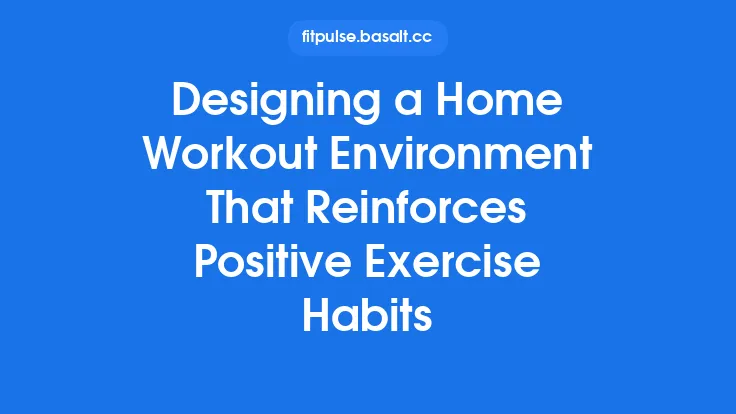When you step into a home workout space, the first things you notice are often how bright the room feels and how fresh the air is. Good lighting and proper ventilation arenât just luxuries; theyâre essential components that affect performance, safety, and overall enjoyment of your training sessions. Below, we explore practical, scienceâbacked strategies to create a wellâlit, wellâventilated environment that works yearâround, no matter the size of your space or the type of equipment you own.
Understanding the Role of Light in Exercise
1. Visual Clarity and Safety
Clear, evenly distributed illumination reduces the risk of trips, slips, and misstepsâespecially when youâre moving quickly between equipment or performing dynamic movements. Shadows can hide obstacles, while glare can impair depth perception. Aim for a lighting level of 300â500 lux in the main workout zone; this range mirrors the illumination found in commercial gyms and provides enough brightness for most activities without being harsh on the eyes.
2. Mood, Energy, and Performance
Light influences circadian rhythms and hormone production. Exposure to coolâwhite (4000â5000âŻK) or daylightâbalanced (5000â6500âŻK) lighting can boost alertness and improve reaction time, making it ideal for highâintensity interval training (HIIT) or strength sessions. Conversely, warmer tones (2700â3000âŻK) are better suited for coolâdown stretches or yoga, helping the body transition toward relaxation.
3. Color Rendering Index (CRI)
A high CRI (â„âŻ90) ensures that colors appear true to life. This matters when youâre checking form in a mirror or monitoring equipment displays. Poor color rendering can distort visual cues, potentially leading to improper technique.
Choosing the Right Light Sources
LED Panels
- Pros: Energyâefficient, low heat output, dimmable, long lifespan.
- Placement: Mount panels on the ceiling in a grid pattern to achieve uniform coverage. For a 12âŻftâŻĂâŻ12âŻft room, three 2âŻĂâŻ2âŻft panels spaced evenly will typically reach the 300â500âŻlux target.
Recessed Downlights
- Pros: Sleek, unobtrusive, can be angled to avoid glare.
- Tip: Use diffusers or baffles to soften the beam and reduce harsh shadows.
Task Lighting
- When to Use: For specific zones such as a weightâlifting platform or a stretching mat.
- Options: Adjustable track lights or clampâon LED lamps that can be repositioned as your workout routine evolves.
Smart Lighting Controls
- Features: Programmable scenes, color temperature adjustments, and integration with motion sensors.
- Benefit: Automatically dim or brighten the space based on time of day or activity, conserving energy while maintaining optimal illumination.
Designing a Lighting Layout That Works
- Map the Space: Sketch a floor plan and mark highâtraffic zones, equipment footprints, and mirror locations.
- Layer the Light: Combine ambient (overall illumination), task (focused on specific activities), and accent (highlighting décor or motivational signage) lighting.
- Avoid Direct Glare: Position lights at least 30° off the line of sight to mirrors and screens. Use indirect lighting (e.g., cove lighting) for a softer overall feel.
- Consider Height: For rooms with high ceilings, use taller fixtures or multiple layers to prevent a âcaveâ effect where the floor feels dimmer than the upper space.
Ventilation Fundamentals for a Home Gym
Why Airflow Matters
During exercise, the body generates heat and releases moisture through sweat and respiration. Without adequate ventilation, temperature and humidity can rise quickly, leading to discomfort, reduced performance, and even mold growth in poorly ventilated spaces.
Key Metrics
- Air Changes per Hour (ACH): Aim for 4â6 ACH in a typical home gym. This means the total volume of air in the room should be replaced 4â6 times each hour.
- Relative Humidity (RH): Keep RH between 40% and 60%. Higher levels encourage condensation and mildew; lower levels can dry out mucous membranes and affect breathing.
Passive Ventilation Strategies
1. Window Placement and Size
- CrossâVentilation: Position windows on opposite walls to create a natural airflow path. Even a modest 2âŻftâŻĂâŻ3âŻft window can provide significant ventilation when opened during workouts.
- Operable Skylights: In rooms without side windows, a vented skylight can release hot air that rises naturally.
2. Vent Grilles and Louvered Panels
- Install adjustable grilles near the ceiling to allow warm air to escape while drawing cooler air in from lower openings.
- Use highâefficiency particulate air (HEPA) filters in grilles if the space is prone to dust or pollen.
3. Door UnderâCut
- A small gap (ââŻÂœâŻin) at the bottom of the door can facilitate airflow, especially when combined with a higher opening elsewhere.
Active Mechanical Ventilation
Exhaust Fans
- Capacity: Choose a fan rated for at least 50âŻCFM (cubic feet per minute) per 100âŻsqâŻft of floor area. For a 200âŻsqâŻft gym, a 100âŻCFM fan will meet the 4â6 ACH guideline.
- Placement: Mount near the ceiling on the side opposite the primary intake to pull warm, humid air out efficiently.
Supply Fans
- Pair an exhaust fan with a lowânoise supply fan to bring fresh air in, maintaining a balanced pressure and preventing drafts that could disturb equipment stability.
Heat Recovery Ventilators (HRVs) / Energy Recovery Ventilators (ERVs)
- When to Use: In climates with extreme temperature differences, HRVs/ERVs exchange stale indoor air with fresh outdoor air while retaining heat (or cool) energy, reducing heating/cooling costs.
- Benefit: Provides continuous fresh air without large temperature swings, ideal for yearâround training.
Integrating Lighting and Ventilation Controls
Automated Sensors
- Occupancy Sensors: Turn lights and fans on only when the space is in use, extending equipment life and saving energy.
- COâ and Humidity Sensors: Trigger exhaust fans when COâ levels exceed 1000âŻppm or RH climbs above 60%, ensuring air quality remains optimal without manual intervention.
Dimmable & Variable-Speed Controls
- Use dimmers for lighting and variableâspeed drives for fans. This allows you to lower light intensity and fan speed during lowâimpact sessions (e.g., yoga) and ramp them up for intense cardio workouts.
Managing Temperature Without OverâCooling
- Zoned HVAC: If your homeâs HVAC system supports zoning, dedicate a thermostat to the gym area. Set it a few degrees cooler than the rest of the house during workouts.
- Portable Air Conditioners or Heaters: For spaces without dedicated HVAC, a miniâsplit system offers precise temperature control with low noise.
- Fans for Air Circulation: Ceiling or floor fans can improve perceived cooling by enhancing evaporative heat loss from the skin, reducing the need for aggressive air conditioning.
Practical Tips for Different Home Gym Setups
| Space Type | Lighting Recommendation | Ventilation Recommendation |
|---|---|---|
| Basement Gym (no windows) | HighâCRI LED panels + task lights; use dimmable controls to mimic daylight. | Install an HRV or dedicated exhaust fan with a makeup air inlet; consider a dehumidifier to keep RH in check. |
| Spare Bedroom | Recessed LED downlights + adjustable desk lamp for stretching corners. | Open the door slightly and use a window fan set to âexhaustâ mode; supplement with a portable air purifier. |
| Garage Conversion | Bright, coolâwhite LED strips along the ceiling; add motionâactivated spotlights for equipment zones. | Add a wallâmounted exhaust fan; if possible, create a vented skylight for passive airflow. |
| Attic Studio | Use diffused skylight lighting during the day; supplement with LED panels at night. | Install ridgeâvent and soffit vents for natural stack effect; add a lowânoise exhaust fan for supplemental airflow. |
Maintenance and Longevity
- Clean Light Fixtures: Dust accumulation reduces light output. Wipe panels and lenses monthly.
- Check Fan Filters: Replace or clean filters on exhaust fans and HRVs every 3â6 months to maintain airflow efficiency.
- Inspect Seals: Ensure window and door seals are intact to prevent unwanted drafts that could affect temperature control.
- Monitor Light Color Temperature: Over time, LED spectra can shift. Use a lux meter and color temperature meter annually to verify performance.
Final Thoughts
A wellâlit, wellâventilated home workout environment does more than just look appealingâit directly influences how effectively you can train, how safely you can move, and how much youâll enjoy spending time in your gym. By combining the right mix of ambient, task, and accent lighting with a thoughtful ventilation strategyâwhether passive, mechanical, or a hybridâyou create a space that supports every type of exercise, from highâintensity cardio to mindful stretching. Implement the guidelines above, adjust them to fit your specific layout, and youâll have a comfortable, energizing home gym that stands the test of time.





